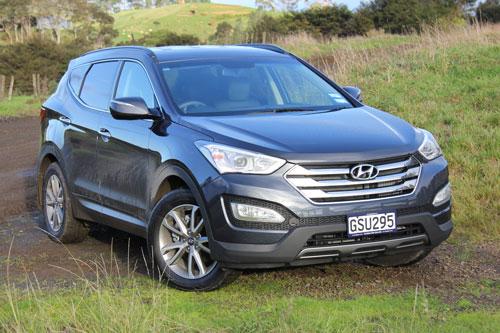Robert Barry drove the four-cylinder 2.2-litre diesel and 2.4-litre petrol Santa Fe Elite models back to back, and found one engine was more impressive than the other.
The new Santa Fe is a great deal sleeker and the coke bottle curves of the previous generation has been replaced by a more contemporary shape and the chrome grille echoes that of the i45 sedan.
A trademark Santa Fe swage line runs from the rear door handle over the rear flank to the indicator lamp but the overall design has a far more international flavour which should extend its appeal beyond current owners.
Hyundai has upped the price of the new Santa Fe range but has added more functionality and features, and both the petrol and diesel Elite models offer a large central touch screen for the navigation, radio, media and Bluetooth audio functions including hands free telephone operation.
Keyless entry and start/stop is standard on the Elite as is Hyundai’s flex-steer electric power steering system which gives the driver the option of three settings; comfort, normal and sport. We found that the normal setting was perfectly adequate for the mixture of urban tarmac and rural gravel roads traversed on the test week.
Other nice touches in the Elite models include the steering wheel controls for the audio, telephone, cruise control and vehicle information settings which are easily operated on the move, as well as electric adjustment for the driver’s and passenger seats, and seat heating for the front and second row of seats.
The leather upholstery can be very cold to sit on first thing after the vehicle has been parked outside of a winters evening, so the three-stage seat warmer for the driver is appreciated.
Although it’s marketed as a vehicle for seven people, the third row of seats is most definitely not suitable for larger children or adults for trips longer than an hour, and this functionality is more likely to be used for shorter hops, such as the school run or taking a group of friends to a rugby game.
While passengers in the third row do get their own air conditioning controls, the windows are rather small and the area does feel somewhat claustrophobic.
The bonus however is that the third row of seats folds flat and creates a large and spacious cargo area of 585 litres (with the second row of seats in place) that will win many fans.
The Santa Fe Elite looks and certainly feels bigger than its predecessor, but thanks to the reversing camera manoeuvring into car parks and reversing out of driveways is made simpler and safer. The rear three-quarter vision is impaired by the large rear pillars, so the camera is a necessity.
On the motorway both cars are comfortable and quiet cruisers and both engines are mated to six-speed automatic transmissions for optimum economy. Hyundai claims the R-series diesel will return an average fuel consumption of 7.3L/100km. We found our test vehicle stayed resolutely on 8L/100km despite several long motorway runs to try and bring the average down.
The diesel Santa Fe doesn’t betray its nearly two tonne kerb weight, it feels quite lithe and responsive, the R-series engine provides plenty of power when needed for overtaking, and we feel it will easily tow its capacity of two tonnes (braked). Even on coarse chip sealed roads the cabin provides a serene and quiet environment.
However the 141kW 2.4-litre petrol Elite paled in comparison to the diesel in terms of economy and off-the-line performance. The petrol engine certainly doesn’t have the low down torque of the diesel, it revs much harder to provide similar performance, and this results in far less efficient fuel economy. Hyundai quotes 9L/100km as its average fuel economy, but we found that 10 to 11L/100km was closer to the mark.
Choosing between the two engines will largely come down to the user’s requirements and the overall whole of life cost, but despite its initial price premium we think the diesel Santa Fe would be the more preferable of the two as a long term fleet vehicle.
Specifications: 2.2-Litre diesel 2.4-Litre Petrol
Body type 5-door SUV 5-door SUV
Drive All-wheel-drive All-wheel-drive
Engine type Inline 4-cylinder Inline 4-cylinder
Engine capacity 2199cc 2359cc
Max power 145kw/3,800 rpm 141kW/6,300 rpm
Max torque 436Nm/1,800 rpm 242Nm/4,250 rpm
Fuel consumption 7.3l/100km 9l/100km
C02 emission 192g/km 209g/km
0 to 100km/h N/a N/a
Airbag 7 7
ESP Yes Yes
Air conditioning Dual zone climate Dual zone climate
Satellite navigation Yes Yes
Cargo cover Optional Optional
Boot capacity 585l 585l
Wheel type 18 inch Alloy 18 inch Alloy
Spare tyre Full size Full size
Estimated running costs
36 months, 60,000km
Price $73,990 $67,990
WOF $180 $180
Fuel $9,470 $11,670
Registration $1,682 $1,293
Servicing to 60k: $1,772 $1,823
Total Tyre cost: $1,116 $1,116
Residual (30%) $22,197 $20,397
Indicative final figure $66,013 $63,675
The running cost model is used for illustrative and indicative purposes only. Adrenalin Publishing Limited accepts no responsibility or liability should any costs indicated in the model change from those published. All residual values are based on a calculated 30 percent as a financial instrument and are not the expected or indicative resale values.



